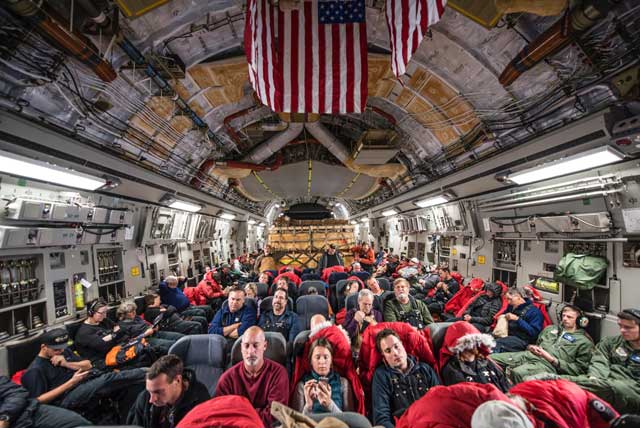Safe landingsFive flights arrive at McMurdo Station in August to prepare USAP for 2014-15 seasonPosted August 29, 2014
A storm packing 80-mile-per-hour winds slammed into McMurdo Station More than 200 people started arriving by U.S. and Australian aircraft on Aug. 24 (local time) after waiting in Christchurch, New Zealand, for a break in the weather. Two passenger flights arrived on Aug. 24, followed by two more on Aug 26. There haven't been any flights to McMurdo since March. "I can tell you that the Con 1 we had last week was one of the worst I’ve seen," said Catherine Salazar, who wintered over at McMurdo this year, working as a utilities mechanic. She has worked on and off with the U.S. Antarctic Program since 2005-06, including several winters. Con 1, or Condition 1, is one of three categories by which weather conditions are defined. Condition 1 represents the worst weather conditions, and can involve wind speeds greater than 55 knots (about 63 mph), wind chills colder than minus 100 degrees Fahrenheit or visibility of less than 100 feet. The August flights are part of what's known as WinFly, for winter fly-in, which brings in mostly support personnel – from mechanics and cooks to carpenters and electricians – to prepare the station to support scientific research across the continent. The field season is scheduled to begin Sept. 29. [See related article — Getting busy: Flights headed to McMurdo Station this month to ready USAP for 2014-15 field season.] The first flight to Amundsen-Scott South Pole Station Airmen from Joint Base Lewis-McChord Shortly after the last WinFly flight arrived – a night-vision goggle mission by the U.S. Air Force that delivered cargo only on Aug. 27 – another condition 1 storm moved into the region. Click here for more WinFly photos. |



For USAP Participants |
For The Public |
For Researchers and EducatorsContact UsU.S. National Science FoundationOffice of Polar Programs Geosciences Directorate 2415 Eisenhower Avenue, Suite W7100 Alexandria, VA 22314 Sign up for the NSF Office of Polar Programs newsletter and events. Feedback Form |





